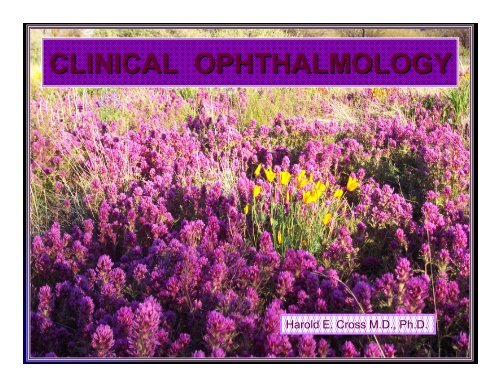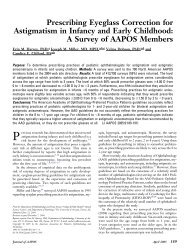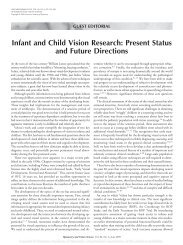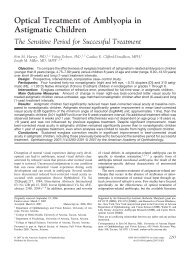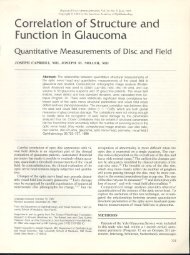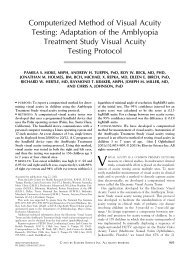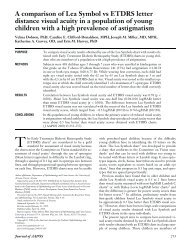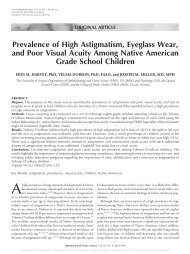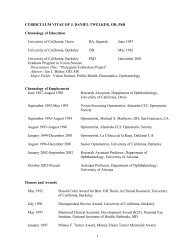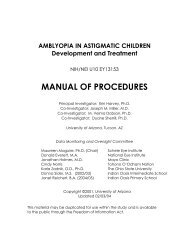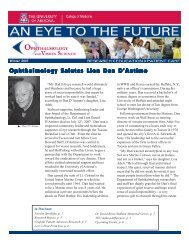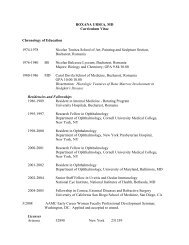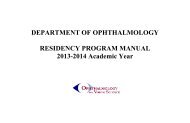CLINICAL OPHTHALMOLOGY
CLINICAL OPHTHALMOLOGY
CLINICAL OPHTHALMOLOGY
You also want an ePaper? Increase the reach of your titles
YUMPU automatically turns print PDFs into web optimized ePapers that Google loves.
<strong>CLINICAL</strong> <strong>OPHTHALMOLOGY</strong><br />
Harold E. Cross M.D., Ph.D.
Ophthalmology<br />
Department of Ophthalmology website:<br />
http://www.eyes.arizona.edu<br />
Medical student teaching program:<br />
http://www.eyes.arizona.edu/medstudents.htm<br />
Fundamentals of ophthalmoscopy:<br />
http://www.eyes.arizona.edu/FundOph.htm
Ophthalmology<br />
Elective offerings for medical students:<br />
Ophth 815A: Intradepartmental clinical elective. 2-4 weeks<br />
available for 4 th year or part of 3 rd year surgical elective<br />
Ophth 815B: Similar to 815A but in private offices of affiliated<br />
faculty, limited to 4 th year students only<br />
Ophth 815P: Phoenix clinical elective 2-4 weeks, 4 th year only<br />
Ophth 800: Elective research rotation within Department, time<br />
and project variable, 4 th year only<br />
Ophth 891A: Extended research opportunities for 4 th year<br />
students interested in ophthalmology as a career
OPHTHALMOLOGICAL CONTRIBUTIONS<br />
to<br />
MEDICAL SCIENCE<br />
1950’s First tissue homograft (cornea) to achieve high success rate in<br />
clinical practice<br />
1960’s First demonstration of lyonization in humans (in X-linked ocular<br />
disorders such as ocular albinism and chorioderemia)<br />
1971 “Two-hit hypothesis” of tumor causation developed by Knutson<br />
using the ocular model of retinoblastoma<br />
1970’s Abnormal crossing of visual fibers demonstrated in human albinos<br />
1986 The first recessive human oncogene located, cloned and sequenced<br />
in an ocular tumor (retinoblastoma)
What is ophthalmology?<br />
Webster’s Unabridged:<br />
The branch of medical science dealing with the anatomy, functions, functions,<br />
and diseases of the eye<br />
Herman von Helmholtz: Helmholtz:<br />
Ophthalmology is for medicine what astronomy is for physics: the<br />
Model
Why study ophthalmology?<br />
“THE EYE IS A WINDOW TO SYSTEMIC DISEASE”
WHAT DO I NEED TO KNOW?<br />
Anatomy and physiology of vision<br />
How to elicit a valid ocular history<br />
How to perform an eye examination<br />
Learn about common eye diseases and their treatment<br />
Understand the presentation and significance of the<br />
more important ocular diseases
Anatomy of human vision<br />
The eyeball and it’s connections
Anatomy of human vision<br />
Associated structures
Anatomy of human vision<br />
The retina
Physiology of human vision<br />
How does the<br />
eye work?
Physiology of human vision<br />
We see best in<br />
bright light!
Correlation of acuity and retinal<br />
histology
The ophthalmic history<br />
A. Chief complaint<br />
B. Onset, duration, and severity of symptoms<br />
C. Associated ocular symptoms such as changes<br />
in vision, photophobia, photopsia, pain, redness,<br />
discharge, diplopia<br />
D. Systemic symptoms, disease, drugs, etc.<br />
E. Prior ocular surgery and/or treatment
The ocular examination<br />
A. Measuring visual function (acuity)<br />
B. External, direct examination (use focused light)<br />
1. Alignment and motility<br />
2. Lid and pupillary functions<br />
3. Degree, type, and location of conjunctival injection<br />
C. Internal examination<br />
1. Note clarity of media<br />
2. Disc color and morphology<br />
3. Macular pigmentation and lesions<br />
4. Appearance of retinal vessels<br />
5. General appearance of retina and RPE
How do we measure vision?<br />
Snellen eye chart
Illiterate<br />
“E’s”<br />
How do we measure vision?<br />
Tumbling E<br />
Allen<br />
pictures
THE VISUAL FIELD<br />
Goldmann perimetry
THE VISUAL FIELD<br />
“An island of vision in a sea of darkness”
THE VISUAL FIELD<br />
Humphrey automated perimeter
THE VISUAL FIELD<br />
Anatomic relationship of<br />
retinal axons at chiasm<br />
Bitemporal hemianopia<br />
Left homonymous hemianopia
External examination
External examination
External examination
External examination<br />
Subconjunctival<br />
hemorrhage<br />
Conjunctival injection
External examination<br />
Subconjunctival hemorrhage
External examination<br />
Conjunctival<br />
injection
Conjunctival<br />
disease<br />
External examination
External examination<br />
Pingueculum Pterygium
External examination<br />
Pterygiae
External examination<br />
Metallic foreign body<br />
Organic foreign body
External examination<br />
Corneal foreign bodies
External examination<br />
Lid foreign bodies
Ophthalmology
External examination<br />
Cataracts
Eyelid anatomy<br />
Tarsal<br />
plate<br />
MEIBOMIAN<br />
GLAND
External examination<br />
Staph folliculitis/blepharitis
Subacute<br />
Blepharitis<br />
Chronic
External examination<br />
Acute blepharitis with internal hordeolum
Chalazia
External examination<br />
Normal tarsal conjunctiva<br />
Cobblestone changes
External examination<br />
Hyphemas
External examination<br />
Hypopyon
The cornea
The cornea<br />
Corneal abrasions
ABRASIONS<br />
Dust storm<br />
The cornea<br />
Fingernails
Cigarette burn<br />
The cornea<br />
Curling iron
The cornea<br />
Automobile air bag abrasions
The cornea<br />
Herpes simplex I keratitis
The cornea<br />
Herpes zoster
The cornea<br />
Keratitis secondary to extended wear soft contact lenses
Ultraviolet keratitis<br />
The cornea
Extensive corneal<br />
edema is your clue<br />
to a perforating injury<br />
The cornea
The cornea<br />
Is it perforated or not?
The cornea<br />
Penetrating corneal trauma with infection
Pediatrics and motility<br />
Measuring vision in children
Pediatrics and motility<br />
Check fixation preference in pre-verbal children
Pediatrics and motility<br />
Versions Ductions
Esotropia<br />
(ET)<br />
Exotropia<br />
(XT)<br />
?<br />
Pediatrics and motility<br />
Orbital floor fracture<br />
with trapped IR
Pediatrics and motility<br />
Amblyopia or “lazy eye”<br />
Definition: Poor vision in the absence of organic disease<br />
von Graefe: “the doctor saw nothing and the<br />
patient very little”
Pediatrics and motility<br />
Amblyopia or “lazy eye”<br />
Etiology:<br />
A. Strabismus (diplopia)<br />
B. Cloudy media (lack of formed images on retina)<br />
C. Refractive errors (blurred vision)
Pediatrics and motility<br />
Amblyopia or “lazy eye”<br />
Treatment: Amblyopia can only develop during<br />
the first 8 years of life, and can only<br />
be treated during this time!<br />
1. Restore clear media and/or correct refractive error<br />
2. Patch the better seeing eye and force brain to accept<br />
clear images from amblyopic eye
Ophthalmology<br />
UNTIL NEXT TIME
GLAUCOMA<br />
What is it?<br />
A disease of progressive optic<br />
neuropathy with loss of retinal<br />
neurons and the nerve fiber layer,<br />
resulting in blindness if left untreated.
GLAUCOMA<br />
What causes it?<br />
There is a dose-response<br />
relationship between intraocular<br />
pressure and the risk of damage to<br />
the visual field.
GLAUCOMA<br />
ADVANCED GLAUCOMA<br />
INTERVENTION STUDY
GLAUCOMA<br />
Intraocular pressure is not the only factor<br />
responsible for glaucoma!<br />
95% of people with elevated IOP will never have<br />
the damage associated with glaucoma.<br />
One-third of patients with glaucoma do not have<br />
elevated IOP.<br />
Most of the ocular findings that occur in people<br />
with glaucoma also occur in people without<br />
glaucoma.
GLAUCOMA<br />
Population distribution of intraocular pressure
Normal vs glaucoma<br />
GLAUCOMA<br />
Some characteristics of IOP<br />
Effects of age and sex
GLAUCOMA<br />
Angle Anatomy
Anatomy of<br />
anterior chamber<br />
angle<br />
GLAUCOMA
GLAUCOMA<br />
How do we measure IOP?<br />
Applanation<br />
Schiotz
GLAUCOMA<br />
Ocular hypertension treatment study<br />
(OHTS study)<br />
GOALS: GOALS: To evaluate the effectiveness of topical ocular hypotensive<br />
medications in preventing or delaying visual field field<br />
loss<br />
and/or optic nerve damage in subjects with ocular ocular<br />
hyper-<br />
tension at moderate risk for developing open-angle<br />
open angle<br />
glaucoma (POAG).<br />
POPULATION: POPULATION: 1636 participants aged 40-80 40 80 years with IOP 24-32 24 32<br />
mm HG in one eye, and 21-32 21 32 in the other, randomly<br />
assigned to observation and treatment groups.
At 60 months, the<br />
probability of developing<br />
glaucoma was:<br />
9.5% in observation group<br />
4.4% in treatment group<br />
GLAUCOMA<br />
OHTS Conclusions
GLAUCOMA<br />
OHTS parameters that<br />
influence the risk of<br />
developing POAG<br />
Age<br />
Cup-disk ratio<br />
Central corneal thickness<br />
IOP
GLAUCOMA<br />
Optic nerve signs of glaucoma progression<br />
Increasing C:D ratio<br />
Development of disk pallor<br />
Disc hemorrhage (60% will show progression of<br />
visual field damage)<br />
Vessel displacement<br />
Increased visibility of lamina cribosa
GLAUCOMA<br />
Cup-to Cup to-disk disk ratio
GLAUCOMA<br />
The histology of glaucomatous optic nerve<br />
cupping:<br />
Normal:<br />
Glaucomatous:<br />
Glaucomatous
Normal<br />
GLAUCOMA<br />
DISK CUPPING<br />
Glaucoma
GLAUCOMA<br />
Glaucomatous cupping
GLAUCOMA<br />
Types of glaucoma<br />
I. Primary:<br />
A. Congenital<br />
B. Juvenile (hereditary)<br />
C. Adult<br />
1. Narrow angle<br />
2. Open angle<br />
II. Secondary<br />
A. Inflammatory<br />
B. Traumatic<br />
C. Rubeotic<br />
D. Phacolytic<br />
etc.
Congenital Glaucoma<br />
Onset: antenatally to 2 years old<br />
Symptoms<br />
Irritability<br />
Photophobia<br />
Epiphora<br />
Poor vision<br />
Signs<br />
Elevated IOP<br />
Buphthalmos<br />
Haab’s striae<br />
Corneal clouding<br />
Glaucomatous cupping<br />
Field loss
Buphthalmos,<br />
glaucomatous<br />
cupping, and<br />
cloudy cornea<br />
OD<br />
Congenital Glaucoma<br />
Haab’s striae<br />
Normal OS
Congenital Glaucoma<br />
Buphthalmos and cloudy corneas
Narrow Angle Glaucoma<br />
Onset: 50+ years of age<br />
Symptoms<br />
Severe eye/headache<br />
pain<br />
Blurred vision<br />
Red eye<br />
Nausea and vomiting<br />
Halos around lights<br />
Intermittent eye ache<br />
at night<br />
Signs<br />
Red, teary eye<br />
Corneal edema<br />
Closed angle<br />
Shallow AC<br />
Mid-dilated, fixed<br />
pupil<br />
“Glaucomflecken”<br />
Iris atrophy<br />
AC inflammation
GLAUCOMA<br />
Anatomy of Angle Closure Glaucoma
Narrow Angle Glaucoma<br />
Treatment: Peripheral<br />
iridotomy
Narrow Angle Glaucoma<br />
Acute angle-closure attack!<br />
Red eye, cloudy cornea, and mid-dilated<br />
non-reactive pupil
Open Angle Glaucoma<br />
Aka: Aka:<br />
chronic simple glaucoma (CSG)<br />
and primary open angle glaucoma (POAG)<br />
Onset: 50+ years of age<br />
Symptoms<br />
Usually none<br />
May have loss of central<br />
and peripheral vision<br />
late<br />
Signs<br />
Elevated IOP<br />
Visual field loss<br />
Glaucomatous disk changes
GLAUCOMA<br />
Treatment<br />
Medical Surgical<br />
Miotics<br />
Beta-blockers<br />
Carbonic anhydrase<br />
inhibitors<br />
Prostaglandin<br />
analogues<br />
Alpha-2 agonists<br />
Argon laser trabeculoplasty<br />
Trabeculectomy<br />
Filtering procedure<br />
Cyclocryotherapy<br />
Cyclolaser ablation<br />
Iridotomy
Structures:<br />
The posterior segment<br />
I. Optic nerve<br />
II. Vitreous<br />
III. Retina and<br />
vasculature<br />
IV. Macula<br />
V. Choroid and<br />
vasculature<br />
VI. Lens<br />
VII. Ciliary body and<br />
zonule<br />
VIII.Pars plana &<br />
plicata
The posterior segment<br />
Evaluation techniques:<br />
I. Direct ophthalmoscopy<br />
II. Indirect ophthalmoscopy<br />
III. Slit lamp and lenses<br />
IV. Ultrasound (A & B)<br />
V. Electroretinogram (ERG)<br />
VI. Electrooculogram (EOG)<br />
VII.Magnetic resonance imaging<br />
VIII. Fluorescein angiogram<br />
IX. Visual fields
Morphology<br />
The lens
Cataracts
Advanced cataract<br />
Cataract<br />
Phacolytic glaucoma
Surgery<br />
Cataract
Ophthalmology
Ophthalmoscopy<br />
Monocular examination:<br />
WA conventional<br />
head<br />
WA Panoptic<br />
head
To dilate or not to<br />
dilate:<br />
Retinal examination
Ophthalmoscopy<br />
Binocular examination:<br />
Slit lamp<br />
Indirect ophthalmoscopy
Ophthalmoscopy<br />
The future?
The ocular fundus
The ocular fundus<br />
Normal<br />
OD OS
The ocular fundus<br />
Where is the macula?
The optic nerve<br />
Normal
The optic nerve<br />
“Normal variants”<br />
Myelinated nerve<br />
fibers
“Choked disc”<br />
The optic nerve<br />
or<br />
Papilledema
Papilledema with<br />
papillary hemorrhages<br />
Dx?<br />
The optic nerve<br />
Dx?<br />
Disc neovascularization
The optic nerve<br />
Optic atrophy
Arterial<br />
occlusions<br />
The retina
The retina<br />
Arterial plaques
Venous occlusions<br />
The retina
Detachments<br />
The retina
Retinal detachment<br />
repair<br />
Before After<br />
The retina
Hypertensive retinopathy<br />
Papilledema, papillary hemorrhages, “cotton wool”<br />
spots, and narrowed aterioles
Diabetic retinopathy<br />
Early background diabetic retinopathy<br />
“Blot and dot hemorrhages”<br />
Hard and soft exudates<br />
Circinate exudates
On insulin<br />
Never on insulin
DIABETIC RETINOPATHY:<br />
Histopathology<br />
•Pericyte loss (physiological role unknown; may stimulate<br />
endothelial proliferation, lead to reduced blood flow)<br />
• Basement membrane thickening membrane thickening<br />
• Capillary acellularity (leads to ischemia)<br />
• Endothelial proliferation: microaneurysms<br />
• Neovascularization<br />
• Macular edema
Diabetic retinopathy<br />
Advanced background diabetic retinopathy
Diabetic retinopathy<br />
Neovascularization
Diabetic retinopathy<br />
Neovascular retinopathy
Diabetic retinopathy<br />
Panretinal photocoagulation<br />
Early reaction<br />
Later changes
Diabetic retinopathy<br />
Advanced stages
Age-related Age related macular<br />
degeneration (ARMD)<br />
Hemorrhagic phase
Age-related Age related macular<br />
degeneration (ARMD)<br />
Atrophic ARMD<br />
Drusen
Age-related Age related macular<br />
degeneration (ARMD)<br />
End-stage gliosis<br />
Laser treatment
Retinopathy of prematurity<br />
Maturity of retinal<br />
vasculature and risk<br />
of retinopathy of<br />
Prematurity (ROP)<br />
(ROP)
Retinopathy of prematurity<br />
(ROP)<br />
Peripheral new vessel growth
Retinopathy of prematurity<br />
Temporal scarring with<br />
dragged macula<br />
(ROP)
THANK YOU ALL FOR LISTENING!


